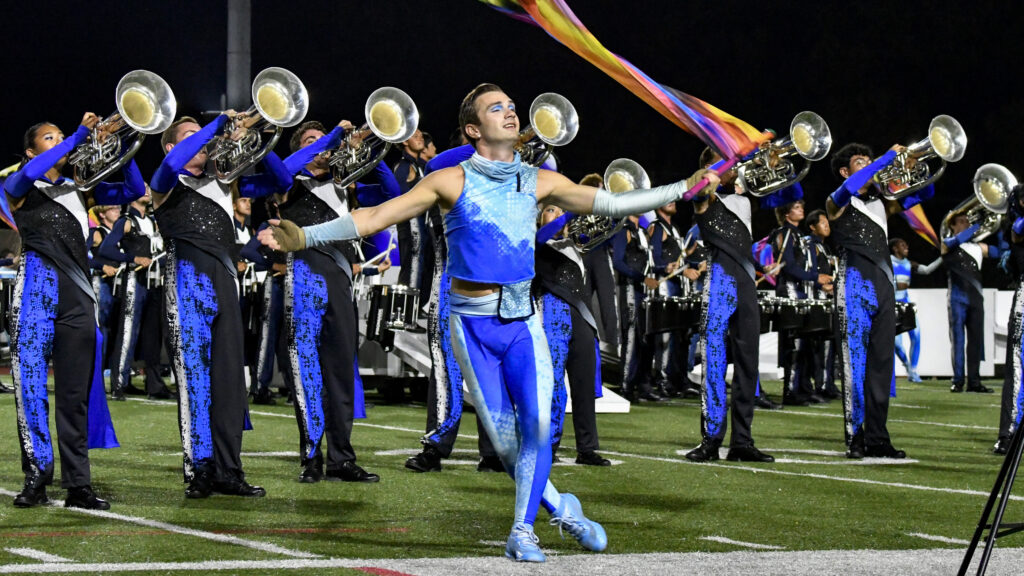The 2011 Open Class Drum Corps International World Championship Prelims In Michigan City, Indiana, was the first time that Open Class corps were scheduled to hold their event at the inviting Ames Field, perfectly sized for the event.
However, the auspicious first-time Prelims was cut way short due to strong thunderstorms that lasted most of the day. All 18 Open Class corps were scheduled into the Finals competition the next day, with the top-12 highest scoring corps being declared as the Open Class finalists.
Finals night was won by Blue Devils B, a corps that had enjoyed an undefeated season until the second-place Oregon Crusaders outscored the California corps by seven tenths of a point in Pennsylvania just three days earlier. All World and Open Class corps competed head-to-head in the World Championship Prelims two days later in Indianapolis. The top-three corps from Michigan City scored well enough to advance into the Semifinals at Lucas Oil Stadium.

Revolution first came to the DCI World Championships in 2001, one year after the San Antonio corps’ first competitive season. The corps took ninth place at the 2001 Division III Prelims and won the title in 2002. After taking 5th place at the 2011 Open Class Finals, the corps finished 29th during the combined Prelims in Indianapolis.
The corps’ 2011 production titled, “Ride!,” was split into three parts. “Movement I—Engine,” combined two works for concert band, Richard Saucedo’s energetic “Windsprints” and Frank Ticheli’s “Nitro.” Saucedo wrote “Windsprints” in 2003, a year that he served as brass arranger for The Cavaliers. In his program notes for the piece, Saucedo compared the work to a “technical race to the finish line,” the rapid and continuous flourish of notes intended to stir the feelings of running a 50- or 100-yard dash.
Frank Ticheli’s “Nitro” was commissioned in 2006 for the 50th anniversary of the Northshore Concert Band of suburban Chicago. The composer was inspired by the prevalence of nitrogen in the earth’s atmosphere, in every living thing, and throughout the universe. Written as a brief fanfare, the work is intended to capture the element’s “life-giving, energizing, healing, cleansing, and explosive” nature.

During this opener, Revolution color guard members utilized five rubber automobile tires as equipment. Other performers picked up the tires with their rifles and used those to toss the tires to other members of the color guard. Near the end of the opener, the brass players formed a circle and rotated it as the spinning of a tire.
“Movement II—Excursion Aero” started with an untitled percussion feature by two members of the corps’ percussion staff, battery arranger Carlos Botello and front ensemble arranger Maverick Peterson. Featured guard members wearing aviator-style caps conveyed that this piece was about flight. Rather than being fast and propulsive, the whimsical work expressed the sense of wonder about flight.
A narrator warned the audience it might experience turbulence, which led into Michael Torke’s “Charcoal,” the seventh and final movement of the composer’s 1988 orchestral suite, “Black and White.” Written for the New York State Theatre and the New York City Ballet, the piece represents the kind of Torke works that have been in demand by ballet troupes due to the splashy conveyance of rhythm and tone colors. Color guard flags of a dark purple and black represented a raging sky, emblazoned with lightning bolts to accompany the turbulence of the aircraft.

Next was Michael Nyman’s “The Heart Asks Pleasure First,” from the film score for director Jan Campion’s 1993 film, “The Piano.” An Emily Dickinson poem provided the title of the piece, and the melodic theme originated as a traditional Scottish melody first heard in 1808. As the narrator announced it was now safe to move about the cabin, color guard members unveiled flags that contained a white silhouette of a plane against a peaceful sky of light blue.
After the audience was thanked for flying Revolution Airlines and welcomed to a “beautiful night in Michigan City, Indiana,” the show moved into “Movement III—Eo Ire Itum,” the title a Latin phrase loosely translated as meaning to travel and move forward.
The final selection of music was Samuel Hazo’s 2002 concert band composition, “Ride,” which gave title to the show. The composition was inspired by memories of being in a speeding car hurtling through the Pennsylvania countryside and watching the blur of scenery pass by at a discomforting speed, a blur captured in the smudged images on the off-white flags.

Michael Boo was a member of the Cavaliers from 1975-1977. He has written about the drum corps activity for more than 35 years and serves as a staff writer for various Drum Corps International projects. Boo has written for numerous other publications and has published an honors-winning book on the history of figure skating.
As an accomplished composer, Boo holds a bachelor's degree in music education and a master's degree in music theory and composition. He resides in Chesterton, Indiana.





